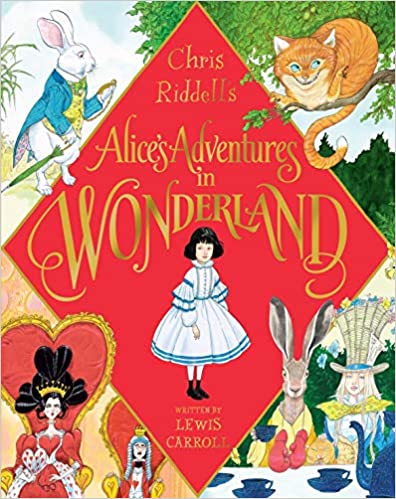
Introduction
Lewis Carroll’s Alice’s Adventures in Wonderland is a literary masterpiece that has captivated readers for generations. This nonsensical children’s novel, published in 1865, follows the fantastical journey of a young girl named Alice who tumbles down a rabbit hole and into a world unlike any other. Filled with talking animals, illogical situations, and playful riddles, the story explores themes of childhood, identity, and the power of imagination.
Summary of “Something Is Killing the Children, Vol. 8” by James Tynion IV
Main Characters: A Cast of Curious Creatures
- Alice: Our curious protagonist, Alice, is a bright and imaginative young girl. Bored by a lazy afternoon on the riverbank, she chases a frantic White Rabbit down a hole, embarking on a journey that challenges her sense of logic and reality. Throughout her adventure, Alice strives to maintain her composure amidst the absurdity surrounding her, reflecting a child’s struggle to understand the complexities of the world.
- The White Rabbit: This harried rabbit, perpetually checking his pocket watch, acts as the catalyst for Alice’s adventures. He serves as a symbol of the passage of time and the fleeting nature of childhood innocence.
- The Cheshire Cat: This enigmatic feline with a mischievous grin possesses the ability to appear and disappear at will. The Cheshire Cat represents the power of riddles and wordplay, often confusing and frustrating Alice with his cryptic pronouncements.
- The Mad Hatter and the March Hare: These eccentric tea party hosts embody the nonsensical nature of Wonderland. Their illogical conversations and chaotic tea parties highlight the absurdity of societal norms and traditions.
- The Queen of Hearts: This tyrannical ruler, with her famous cry “Off with their heads!”, represents authority figures who demand absolute obedience and punish without reason.
The characters in Alice’s Adventures in Wonderland are not simply fantastical creatures; they serve as playful metaphors for the complexities of life and the challenges of growing up.
Plot: A Whimsical Quest Through Wonderland
The main conflict of the story arises from Alice’s desire to return home and the increasingly bizarre situations she encounters in Wonderland. As she navigates this topsy-turvy world, she participates in peculiar games, engages in nonsensical conversations, and faces challenges that defy logic.
The plot unfolds episodically, with Alice encountering various characters and situations that have little to no connection to each other. This episodic structure reflects the dreamlike quality of the story and emphasizes the nonsensical nature of Wonderland. There’s no clear resolution as Alice wakes up at the end, leaving readers questioning the reality of her experiences.
Setting: A World Where Logic Takes a Back Seat
The setting of Alice’s Adventures in Wonderland is a fantastical underground world known as Wonderland. This vibrant and nonsensical realm is characterized by illogical changes in size, talking animals, and unpredictable occurrences. The constant shifts in scale and the bizarre rules that govern Wonderland create a sense of disorientation and unease for Alice. This fantastical setting allows Carroll to explore themes of childhood fears and anxieties through a playful and imaginative lens.
Themes: A Deeper Look Beneath the Surface
Despite its whimsical facade, Alice’s Adventures in Wonderland explores several profound themes.
- Childhood and Identity: The story reflects the challenges of growing up and finding one’s place in the world. Alice’s journey can be seen as a metaphor for a child’s struggle to understand societal norms and expectations.
- The Power of Imagination: The fantastical world of Wonderland celebrates the boundless potential of imagination. Alice’s ability to adapt and thrive in these bizarre situations highlights the importance of creativity and open-mindedness.
- The Absurdity of Language: The nonsensical conversations and illogical wordplay throughout the story challenge traditional logic and highlight the limitations of language. This playful exploration of language encourages readers to question the world around them and think outside the box.
The recurring motif of doors and keys represents Alice’s search for answers and her desire to return home. These elements symbolize the challenges of navigating through life and the quest for meaning and understanding.
Author’s Narrative Style: A Playful Dance with Language
Carroll’s writing style is playful and whimsical, mirroring the fantastical setting of his story. He employs clever wordplay, witty riddles, and nonsensical puns, creating a sense of amusement and bewilderment for the reader. The narrative seamlessly blends elements of fantasy, satire, and philosophical reflection, keeping readers engaged and entertained throughout their journey through Wonderland.
Author’s Point of View: Through Alice’s Curious Eyes
The story is narrated from the first-person perspective of Alice. This allows readers to experience the events of the story through her eyes, sharing her confusion, curiosity, and occasional frustration. By adopting Alice’s perspective, Carroll invites readers to step into a childlike mindset and embrace the wonder and absurdity of Wonderland.
Personal Reflection: A Timeless Tale of Imagination
Alice’s Adventures in Wonderland has captivated readers for over a century, and its enduring appeal lies in its ability to spark imagination and challenge conventional thinking. The story’s whimsical characters, nonsensical logic, and underlying themes continue to resonate with readers of all ages.
One of the most striking aspects of the novel is its exploration of the power of imagination. Alice’s journey through Wonderland demonstrates the limitless possibilities of the human mind. By embracing the absurd and questioning the ordinary, we can unlock new perspectives and creative solutions.
Additionally, the story’s playful use of language and its subversion of traditional storytelling conventions have influenced countless writers and artists. Carroll’s innovative approach to narrative has inspired generations of creators to push the boundaries of literary and artistic expression.
Conclusion
Alice’s Adventures in Wonderland remains a timeless classic that continues to enchant and inspire. Its whimsical characters, nonsensical logic, and underlying themes of childhood, identity, and imagination have solidified its place in literary history. By exploring the power of imagination and challenging conventional thinking, Carroll’s masterpiece invites readers to embark on their own extraordinary adventures.


